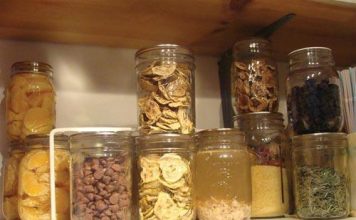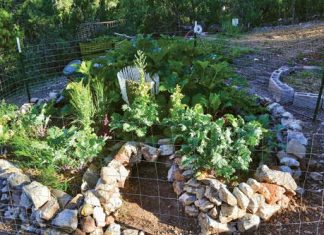 |
|
| Issue #150 • November/December, 2014 |

In 1993, my husband and I did something most people merely dream about: we chucked our professional nine-to-five jobs, left urban California, and settled in a rural home in southwestern Oregon. Unable to find work in our fields, we began a home woodcraft business. For the past 21 years (and a subsequent relocation to north Idaho), that woodcraft business has been virtually our sole source of support. It hasn’t made us rich, but it’s allowed us to live our dream of homesteading.
After many questions and inquiries about starting a home craft business, it gradually occurred to me that the operative word in this subject is home, not craft. In other words, it’s the fact that we work at home which spurred more interest than making our particular craft.
Working at home is, or should be, a goal for most homesteaders. The ability to avoid a commute and have flexible hours means your income-producing methods don’t necessarily conflict with your homesteading ambitions.
So here’s the $64,000 question how do you start working at home? What’s the secret?
Putting aside the “envelope stuffing” scams, there are many ways to work from home, including cyber- or tele-commuting. But I’ve found many people are intrigued by how we turned our woodcraft hobby into a woodcraft business.
We’ve learned that a successful home business is the intersection of three critical components: passion, niche, and marketability. These three factors are the secret behind nearly every successful home business.
What’s a passion?
Quite simply, a passion is something you do, make, or study without reimbursement or monetary compensation of any kind. It’s something that lights your eyes and sets you on fire. It’s something you pursue regardless of how much time and money it costs you. You enjoy meeting and mingling with people who share the same interests. You read and research the subject compulsively. You put in a great deal of practice or effort into becoming an expert.
I once met a woman who had a passion for medieval nunneries. She could (and did) talk for hours about the beliefs, habits (both clothing and behavior), prayers, schedules, architecture, and other aspects of medieval convents. Her research resulted in a number of costuming efforts and beautifully-researched articles which she published in obscure journals. She was considering writing a book and self-publishing it.
Few other people shared her passion, but she didn’t care. What drove her was a dedicated love of history and a realization that not enough serious academic interest had been dedicated to this group, so she stepped in to fill that gap. She is making her own unique contribution to the worldwide Body of Knowledge.

One of the ways we market our woodcraft product is to attend fairs and shows.
What is a niche?
A niche is just that an area which hasn’t been filled to capacity.
We once met a woman at a craft show who made cutesy pink and blue ceramic dragons that bore an uncanny pastel resemblance to Barney the Dinosaur. They were truly hideous. But she was passionate about her dragons, loved making them, put much time and effort into perfecting them … and was bitterly disappointed when they didn’t sell.
The brutal truth of the matter was not enough people shared her niche interest. She made a professional product and had found a niche, true not many other people were making cutesy pastel ceramic dragons but no one was willing to dig into their wallet to support that niche.
Likewise, the medieval nunnery expert was unable to turn her passion into a business. To put it simply, their niches were not marketable.

Another marketable skill is writing. Here I am interviewing Dave Duffy.
What is marketability?
This leads to the third and arguably most important component, marketability. Niches exist all over the place, as do passions. But it’s rare to find passions and niches with sales potential.
Marketability is the critical factor most entrepreneurs don’t want to hear about. They prefer to turn a blind eye to the fact that not enough people may share their passion for their niche idea enough to be willing to shell out money for it. And let’s be realistic: money is what differentiates a business from a hobby.
We succeeded with our woodcraft business because we found a marketable niche. But it was no accident it was a calculated risk.
My husband and I used to be very active in Renaissance and Medieval reenactment groups (which is where I met the aforementioned woman who was passionate about nunneries). We noticed that almost without fail, people who attended reenactment events carried one of two things: a knife or a drinking vessel.
When we took the plunge and relocated to rural Oregon, we needed a way to make a living. Job searches in our fields came up empty; so instead of taking a series of minimum-wage jobs, we cast around for a way to make a living at home. It was then that we recalled our passion attending Renaissance and Medieval reenactment events and a potentially marketable niche: the things people often carried with them, namely knives and drinking vessels.
My husband is not a metalworker, so making knives was out of the question. But he had a longtime interest in woodworking, so he started to tinker with wooden drinking vessels that would fit the needs of historical re-enactors.
The rest is history. We’ve been making wooden tankards from home for more than two decades, wholesaling them all over the country to vendors who mostly do Renaissance Faires and Medieval history events. (We’ve also expanded into Oktoberfests, beer festivals, and other appropriate functions.)
In short, we looked around us, saw what people liked, and found a niche that was marketable. We saw large numbers of people who had a similar passion, namely Renaissance and Medieval reenactment. These people were willing to pay money for a historically-accurate drinking vessel that was well-made and affordable. We stepped in to fill that niche.
Examples of blending passion, marketability, and niche can be found no further than the magazine you’re holding in your hands. Backwoods Home Magazine was born out of one man’s passion. In 1989, Dave Duffy took his passion for independence and rural living (as well as his knowledge of journalism) and tapped into a marketable niche of people who were tired of government interference and longed for rural independence. Dave had the passion and dedication to work hard, hire similarly passionate people, and put out a quality magazine for the last 25 years.

Tankards ready for gluing
A business can be anything
A home business can consist of anything. When people look at our woodcraft business, they sometimes erroneously assume a home business must consist of a physical craft, such as our wooden tankards. But that’s not necessarily the case.
What often escapes people is that knowledge is just as marketable a product as things. You can sell knowledge to people who are hungry for information on a particular subject.
For example, I am a passionate canner. But I can’t “sell” canned goods. What I can sell is my knowledge of canning. I realized this after readers would besiege me with questions whenever I wrote about canning on my blog (www.rural-revolution.com). I recognized that canning is experiencing a huge resurgence of interest among independent-minded people, so I decided to sell my knowledge. I pulled together a series of inexpensive e-booklets on canning (www.selfsufficiencyseries.com) to help people share my passion for food preservation.
Don’t ever underestimate the power of knowledge.

Glue drying
Don’t let the stool topple
Think of passion, marketability, and niche as legs of a stool. All three legs are necessary for the stool to stand. Take away one thing say, the marketability aspect and the stool topples. That’s why the vendor couldn’t sell her ceramic dragons.
A man named Dave Westbrook successfully utilized the three legs of the stool. He took a passion (country living) and discovered there was a huge interest in it (niche) and that people were willing to hear him speak and pay for his expertise in helping them relocate (marketability). As a result, he was able to start Country Living University (www.countrylivinguniversity.com) which assists people in finding their rural home. He also formulated a business model for an information-based home business (www.countryhomebusiness.com) to help people achieve their goals of working from home.
Dave talks about what he calls the profitability test. “Google some key words that correspond with your interest,” he suggests, “and see if anyone is advertising the same thing. Competition means there’s a viable market for that information. No competition means there’s no market.” He also suggests using Amazon.com as a sort of profitability search engine. Search on Amazon.com using your particular niche key words, and see what kind of information others are willing to pay for.
It’s astounding what kind of information and/or materials can be sold online. Dave points to people teaching music online (even live lessons through Skype); selling physical as well as digital products; audio products such as MP3 downloads and CDs; video products through YouTube or streaming; written products such as PDFs, Kindle or Nook ebooks, e-magazines, and special reports.
“In today’s market,” says Dave, “it’s wise to offer a blend of physical and informational products.”
It seems counterintuitive, but it’s not necessarily a good thing if there’s no competition for your niche. Instead of being a wide-open opportunity for you, it may mean there aren’t enough people willing to pay for your product or expertise (such as pastel ceramic dragons or information on medieval nunneries).

After tankards are glued and sanded, we put the handles on. Then they get two coats of varnish.
Don’t quit your day job
The one thing to keep in mind about a home business of any kind is that it will not be an overnight success. For that reason, I strongly suggest you don’t quit your day job until such time as you’re bringing in sufficient income to support you and your family.
We all go into business with a touching faith that our product will hit the market and become an instant and overnight success. This rarely happens.
This is a classic case of “do what I say, not what I do,” since my husband and I didn’t follow this advice. We quit our jobs and moved to the country, where we naively expected it to be a simple matter to find work in our fields. When that didn’t happen, we started our craft business.
And let me tell you, we were motivated to get that business up and running. Zero income will do that. But because we jumped into the pool without first checking to see if there was any water (so to speak), that decision plunged us into a state of poverty that lasted 10 years. So listen to our words of experience: Don’t quit your day job.
There are obviously a number of factors that contribute to starting your business. Are you the primary breadwinner for the household? Are you a stay-at-home parent? Are you deep in debt? Do you have young kids, or are they older? Do you homeschool or do the kids go to school? Do you have other obligations on your time, such as caring for elderly parents or farm animals?
There is nothing on your plate nothing! that won’t be made more complicated if you up and quit your day job to devote your time to your start-up home business. A lack of reliable income will jeopardize your ability to pay your bills, care for your children, or maintain your farm.
Devote your evenings, weekends, holidays, and other available time to building your business. Yes, it essentially means you’ll be working another (unpaid) job, but that’s what it takes. Remember your passion. That passion and vision is what will carry you through hard times and long hours.
The corollary to this is to be as frugal as possible during this time. This means being frugal in your personal spending as well as frugal in your business’s startup costs. You don’t need the best of the best while getting your business off the ground, unless it impacts the quality of your product. Stay thrifty.

The inside of each tankard is double-coated with a food-safe epoxy resin and dried.
Connections
The old real estate adage of “location, location, location,” can be modified to fit entrepreneurs as “connections, connections, connections.” That’s why “networking” was the buzzword of the 80s: people finally grasped how connections can make or break a business. These connections can be developed through your passion, to tap into your niche, and become marketing tools for your product.
Today we have opportunities for connections that didn’t exist 10 years ago. Email, Twitter, Facebook, podcasts, YouTube, blogs, vlogs, Etsy stores, websites, ebooks, apps, eBay, Tumblr, Reddit, Instagram, Pinterest, articles (both print and online) … the list goes on and on.
There are a few things to keep in mind. One, you can’t do it all or at least, not yet. Pick something (in my case, a blog) and start with that. You need to build a platform upon which to build your business.
This advice applies to both tangible products (i.e., a craft) as well as information products. Quite frankly, if no one knows about you, they’re not going to buy what you have to sell.
Once you establish a platform, spread the word. Ask others to cross-link, trade advertising, post guest commentary, or otherwise exchange information. The whole idea of establishing connections is to form as many ties, virtual and personal, as possible.
An underappreciated aspect of building a successful platform is courtesy. Plain ol’ niceness. Quite frankly, no one wants to work with a jerk. Remember, you catch more flies with honey than vinegar. If you make honest efforts to deal respectfully with other bloggers, merchants, readers and posters, customers, wholesalers, or anyone else you come in contact with, then they’ll be inclined to continue working with you.
In our woodcraft business, we learned the crafting world is reasonably small and intimate. A bad reputation may precede you and you may find yourself having a hard time booking shows or selling your products.
In our modern information age, a sterling reputation is even more critical. Honesty, truthfulness, being courteous and helpful, keeping your promises … believe me, if you fail in any of these aspects of reputation, word will spread online.

Before the guarantee card is placed, each tankard is tested for leaks.
Success feeds on success
Frustratingly, active marketing is the key to success for any business. I say “frustratingly” because frankly not many people enjoy marketing. They enjoy working on their product; what’s not as enjoyable is selling it.
Marketing requires you to wear a number of hats you may not have worn before. It means finding your way around the internet and social media sites in ways you never bothered learning. Thankfully, this doesn’t mean you have to be a computer geek and figure out HTML coding, since most online programs are made for computer idiots (like me); however, it does mean you have to make the effort. Today it’s a rare business that can succeed without an online presence of some sort.
The funny thing about starting a business particularly with the online and social media options we have today is success will breed success. The more you actively market your product online and in person, the more connections you’ll make; the more connections you make, the more word will spread; the more word will spread, the more your product will sell.
Please don’t misunderstand: all this takes hard work. But you’re passionate about it, aren’t you? Wouldn’t you rather be building a business you’re passionate about than grinding along in the same ol’ nine-to-five routine working for someone else? Work is more tolerable if it’s something you want to do, even if it has unpleasant aspects (after 21 years in a woodcraft business, we still hate sanding).

Finished tankards ready to be packed for shipping
Think big
In Michael Hyatt’s excellent book Platform, he summarized the steps to achieve success from an earlier book entitled The Magic of Thinking Big by David Schwartz (originally published in 1959). I thought his points were extremely relevant for how to turn a passion into a business. It might seem corny, but try the following steps:
Imagine the possibilities. Let your dreams soar. It doesn’t cost anything to imagine making a million bucks a year or buying your ideal homestead in the country or writing a travelogue about a trip around the world.
Write down your dream. Committing the dreams to paper can begin to trigger concrete actions toward achieving those dreams.
Connect with what is at stake. Mr. Hyatt points out how people often omit this step, but it’s crucial. Why is your goal important? What is at stake if you don’t achieve that goal? What will you have to give up in order to achieve it? Your answers “provide the intellectual and emotional power to keep going when the paths become difficult.”
Outline what would have to be true. For example, if a home business is your goal, you need to ask what would have to happen to make that goal come true. You would have to create a product you’re passionate about, and it has to fit a marketable niche. In other words, start with the dream or goal, and work your way backward.
Decide what you can do to affect the outcome. This step, notes Hyatt, is where you transition from the big picture to daily actions. “This is where people often get derailed,” Hyatt notes. “They can’t see all the steps that will take them to their goal. So rather than doing something, they do nothing.” In short, what can you do today to move toward your dream?
Determine when this will happen. As Hyatt says, a goal is simply a dream with a deadline. Everyone knows the effectiveness of deadlines in bringing projects to fruition through a sense of urgency. Force yourself to assign a date to every goal.
Review your goals daily. Don’t just write down this exercise and then lock it in a drawer forever. Nothing will get done that way. By reviewing your goals daily and assessing what you can do today to work toward those goals, you’ll take concrete steps toward achieving them.
Now if you think this whole exercise is hokey beyond belief, you’re free not to follow it. But who knows? Maybe by following these steps, you can create that home business you’ve always wanted.

A home business is just that our kitchen table is often used for production.
A successful example
Examples of people who have built a successful home business on the three legs of the stool are legion. I spoke to one such person, Mark Goodwin of PrepperRecon.com, who started a business which intersects passion, niche, and marketability very well.
Mark developed an interest in preparedness by an early exposure to the Boy Scouts where his troop leader took the Scouting motto of “Be Prepared” seriously. This attitude was reinforced by watching how his grandparents lived on their rural Kentucky farm. But, as with so many people, preparedness fell by the wayside as he moved into adulthood.
It was the 9/11 terrorist attack, then later the 2008 housing bubble, that rekindled his interest in preparedness into a passion and a desire to make sure his family was safeguarded to the best of his ability.
As his knowledge and expertise on the subject grew, Mark realized an enormous number of other people shared his interest. “The first podcast I ever listened to was Follow the Money with Jerry Robinson,” he recalls. “He talked a lot about hedging yourself financially and even touched on preparedness. In one of his shows, he spoke about turning your passion into a business and suggested starting out with a blog. I didn’t know any better, so I started PrepperRecon.com about two and a half years ago. Like a tree, it started growing very slowly. A year later, I decided to add a podcast to the website. I sent invitations to some of the folks in the preparedness community who I respected and many of them accepted. I started with just a headset mic and free recording programs. Eventually, I started getting offers from people who wanted to advertise on PrepperRecon.com. I accepted those who I felt were pertinent to the Prepper Recon message and it began to generate a little income.”
Mark began writing fiction (specifically dystopian prepper fiction) and began self-publishing his books, which developed a respectable following. About this time, the restaurant where he worked went into a decline and eventually closed. Mark and his wife made the decision to launch full-time into the side-business he had created. They doubled down on their frugality, he selectively upgraded his equipment, he broadened into podcasts and an online store, he cultivated connections among the prepper community, and he continued writing and publishing fiction.
As he worked, his gamut of information and products began to snowball and experience higher exposure and better sales. Mark’s success is based on a number of contributing factors his willingness to work hard, to broaden his contacts, and to produce high-quality products but they can all be traced back to the intersection of passion, niche, and marketability.
It’s still a job
What escapes some people is that turning a passion into a business is a full-time job.
Unlike a “real” job, turning your passion into a business will always retain elements of fun. It will always have a bedrock of the enthusiasm that launched you into the business to begin with. But it’s no longer a hobby; it’s a job, and it must be treated as such. You’ll need to put in regular hours, hard work, dedication, and all the other tangible and intangible qualities you applied to your other job.
In Mark Goodwin’s case, he sets himself a goal of writing a book every four months to build his stable of literature. He adds new products to his store; he puts out podcasts twice a week; and he updates his blog regularly. In short, he applies himself professionally to what has become his primary source of income.
My husband and I tried to apply a degree of seriousness and professionalism from the beginnings of our woodcraft business. Oddly, it was other people who didn’t understand that just because we worked at home, we were working. A lot of folks didn’t understand why we couldn’t just drop what we were doing and visit. It would be like dropping into someone’s office and spending an hour gossiping it just isn’t done.
The ability to work from home makes an independent homesteading life far more doable. I urge you to examine your passions and realistically assess if any one of them can be successfully launched into a business.
Good luck and happy sales.
Product Review Big Blok™

In May 2014, I attended a Preparedness Expo in Prosser, Washington. One of the vendors was selling a series of sturdy plastic containers called Big Bloks™ (www.bigbloks.com). I’d never seen such a gizmo before and frankly, from a preparedness standpoint, I was captivated.
Big Bloks™ are described as “multi-purpose containers built with functionality and flexibility in mind.”
The units come in single, double, and triple sizes (10 gallons, 23 gallons, and 42 gallons, respectively) in order to maximize the adaptability. They are stand-alone or stackable. They can create towers or walls. The large openings mean they are easy to fill with bulky items. They can be used for anything from landscaping to agricultural uses to hazardous cleanup to barriers to construction. They are also foodsafe and can store potable water. They are water-proof and vermin-proof. Colors range from bright to subdued.
I was particularly taken with the demo that showed how these units can be used as retaining walls with a preparedness adaptation. I thought it was a marvelous idea that they could be filled with survival gear, food, medical supplies, and other preparedness items, then stacked to form a barrier wall or retaining wall. The wall could then be covered with dirt and planted over.
Impressed, I obtained two of the single units and took them home to see what they could do. The first thing that struck me was how capacious they are. Each unit has a 10-inch opening and a 10-gallon capacity. The wide opening is what makes these units so useful. We were able to fit some bulky items inside.
My husband and I decided to use the two single units as caches for survival gear. We started filling them with necessary items and couldn’t believe all the items that fit inside. It became a challenge to see how much we could stuff in there. This is what we ended up with packed into one unit for our family of four:
- Lifestraw and water purification tablets
- Toilet paper, feminine hygiene products
- Soap (liquid)
- Bagged tinder (dryer lint, crumpled newspapers, thin sticks), box of strike-anywhere matches
- First-aid kit, OTC medicines
- Emergency Mylar blankets (4), rain-proof ponchos (4), mosquito netting (1)
- High-lumen flashlights (3) and batteries
- Socks (4 prs), gloves (4 prs), bandanas (8)
- Jar of peanut butter, box of granola bars, jar of hot chocolate mix
- Camp mess kit, plastic cutlery, paper cups
- Pairs of eyeglasses (one prescription, one reading), 4 small Bibles
- 500 feet of paracord, box of safety pins, roll of duct tape, sturdy knife
And keep in mind this was just one unit. We have a second unit as well.
As my husband pointed out, the true value of these units as caches is the potential for specialization. A unit can contain ammo, food, water, medical supplies, camping supplies, or it can contain a little of everything. And don’t forget that after emptying your cache, you have a versatile and rugged container available for reuse.
The manufacturers have constructed these blocks to be as useful as possible. They can be used as construction blocks for either linear or curved structures. Think of them as oversized Legos and you’ll get the idea … but they’re Legos that can be filled.
The blocks can be purchased with a variety of adaptations, including a custom-fitted toilet seat. Other options include threaded inserts at top, bottom, and sides (for coupling and attachments); clips, straps, and thumbscrews for coupling; hand-operated transfer pump; and lift straps for handling with a shoulder pole, hook, or forklift.
From my standpoint, the one concern is price. Single units are $66; double units are $95; and triple units are $140 (volume discounts are available). But considering the degree of rugged sturdiness and variety of ways it can be used, I find the prices fair and understandable.
I can highly recommend adding at least a few of these units to the repertoire of all preppers. The scope of possibilities for their use makes Big Bloks™ hard to beat.














